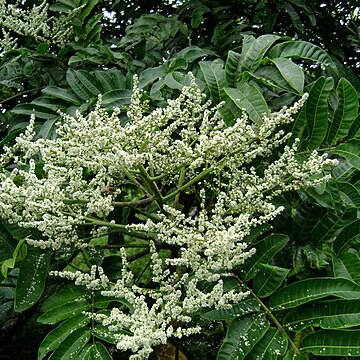Tree up to 30 m high and 70 cm Ø. Buttresses sometimes present, ½-1½ m high, 1-3 m wide, 5-10 cm thick. Bark grey-brown or brown, smooth to rough, finely superficially fissured. Leaves imparipinnate, (7-)13-15(-21)-foliolate; rachis 20-50 cm, petiole 8-15 cm, both puberulous or tomentose. Leaflets chartaceous to subcoriaceous, elliptic to elliptic-lanceolate or ovate to lanceolate, 4-20 by l½-6½(-8½)cm, entire; without domatia; puberulous especially on the midrib, nerves and veins below, sometimes also on the upper surface especially on midrib and nerves; base slightly unequal, obtuse or slightly cuneate; apex acute, acuminate, or obtuse; nerves 9—16 pairs; veins reticulate, some ± perpendicular to the nerves, faint on both surfaces, sometimes distinct below; lateral petiolules c. l/2 cm, terminal one up to 3 cm. Inflorescences paniculate, terminal, sometimes also with some axillary ones in the leaf axils at the end of twigs, very rarely axillary only, up to 30 cm long, puberulous to tomentose, branches up to 26 cm; bracts triangular to linear, ⅓-l mm long; pedicels very short, c. l/3 mm. Flowers cream white, rarely pink. Calyx lobes slightly triangular, 1-1½ mm long. Petals ovate to ovate-oblong, sometimes broad-elliptic, 1¾-2 by 1-1¼ mm, sparsely pilose on the inner surface. Stamens l-2¾ mm; anthers broad-ovoid, c. ¾ mm long; staminodes in ♀ c. ½ mm. Disk discoid, ⅔-1¼ mm Ø. Ovary subglobose, c. 1 mm Ø, papillose; pistillode in ♂ c. ⅔ mm long. Drupe subglobose, 4-8 mm Ø, black when ripe, exocarp not separating from the mesocarp in ripe fruits.
More
Dioecious tree to 30 m high. Branchlets pubescent, with prominent lenticels. Leaflets mostly 11–19, elliptic, oblong-elliptic or lanceolate, obtuse to acuminate, ± pubescent on undersurface, mostly 4–15 cm long and 1.5–5 cm wide; base often asymmetric, obtuse or acute; secondary veins mostly 9–16 pairs; lateral petiolules 2–5 mm long; terminal petiolule 15–30 mm long. Calyx lobes broadly ovate, ciliate, 0.8–1 mm long. Petals narrowly ovate, elliptic or obovate, glabrous outside, pilose inside in lower half, 2–2.5 mm long. Disc 10-lobed. Male flowers: stamens inserted below alternate disc sinuses; anthers 0.8–1 mm long; filaments 1–1.2 mm long. Female flowers: ovary ovoid to subglobose, papillose, sometimes pilose. Style obscure; stigmas ± united. Drupe subglobose, 4–8 mm diam., black.
Primary, dryland rain-forest, also in inundated forest along rivers, sometimes in clearings, secondary forest, or savannahs, rarely in forest on ultra-basic rock or on limestone; at elevations from sea-level up to 1,950 metres.
More
Primary, dryland rainforest, also in inundated forest along rivers, sometimes in clearings, secondary forest, or savannahs, rarely in forest on ultra-basic rock or on limestone; from sea-level up to 1950 m. Fl. fr. Febr.-Dec.
Grows in coastal lowland complex mesophyll vine forest.
Can be grown by cuttings or seedlings. Seeds needs soaking.

